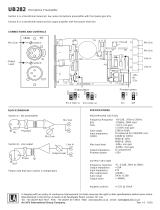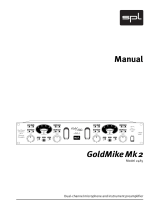Phoenix Audio DRS-Q4M Owner's manual
- Category
- Musical Equipment
- Type
- Owner's manual
This manual is also suitable for
Phoenix Audio DRS-Q4M is a versatile audio processor that combines a microphone preamplifier, DI input, and a 4-band gyratory-based EQ in a single unit. Its Class A output stage and transformerless Class A mic input technology deliver a warm, "valve-like" sound. The DRS-Q4M provides a wide range of features for shaping and enhancing audio signals, making it suitable for various applications in recording, mixing, and live sound.
Phoenix Audio DRS-Q4M is a versatile audio processor that combines a microphone preamplifier, DI input, and a 4-band gyratory-based EQ in a single unit. Its Class A output stage and transformerless Class A mic input technology deliver a warm, "valve-like" sound. The DRS-Q4M provides a wide range of features for shaping and enhancing audio signals, making it suitable for various applications in recording, mixing, and live sound.







-
 1
1
-
 2
2
-
 3
3
-
 4
4
-
 5
5
-
 6
6
-
 7
7
Phoenix Audio DRS-Q4M Owner's manual
- Category
- Musical Equipment
- Type
- Owner's manual
- This manual is also suitable for
Phoenix Audio DRS-Q4M is a versatile audio processor that combines a microphone preamplifier, DI input, and a 4-band gyratory-based EQ in a single unit. Its Class A output stage and transformerless Class A mic input technology deliver a warm, "valve-like" sound. The DRS-Q4M provides a wide range of features for shaping and enhancing audio signals, making it suitable for various applications in recording, mixing, and live sound.
Ask a question and I''ll find the answer in the document
Finding information in a document is now easier with AI
Other documents
-
Limit FPS9150 Datasheet
-
DAP Audio ADI-101 User manual
-
 LA Audio Electronic Microphone Preamplifier UB282 User manual
LA Audio Electronic Microphone Preamplifier UB282 User manual
-
Saramonic SmartRig + User manual
-
 Sound Performance Lab GOLDMIKE MK2 2485 User manual
Sound Performance Lab GOLDMIKE MK2 2485 User manual
-
PyleHome Indoor Outdoor PA Horn Speaker User manual
-
APM AAM-5005aM-ICU User manual
-
Waves GTR Hardware Interface Manual
-
Mackie 820i User manual
-
Mackie SR324-VLZ User manual








